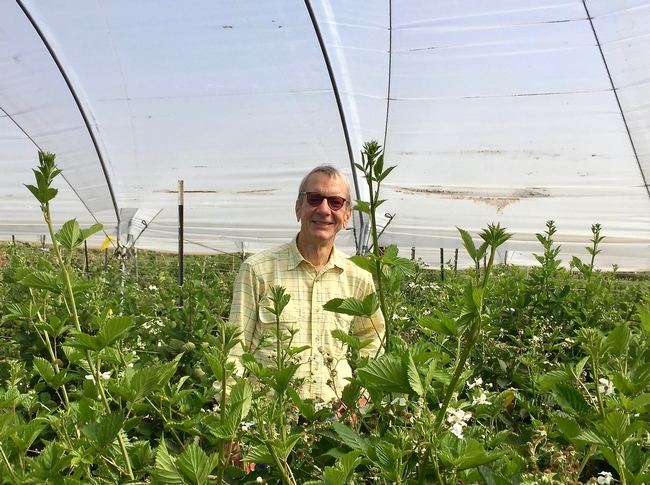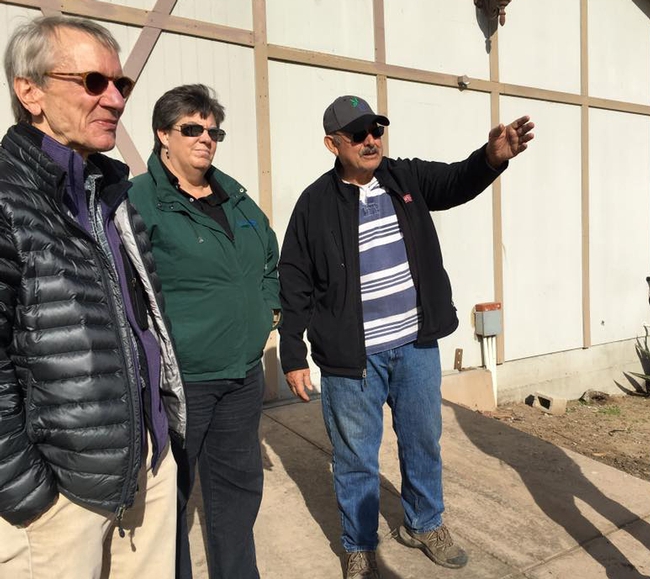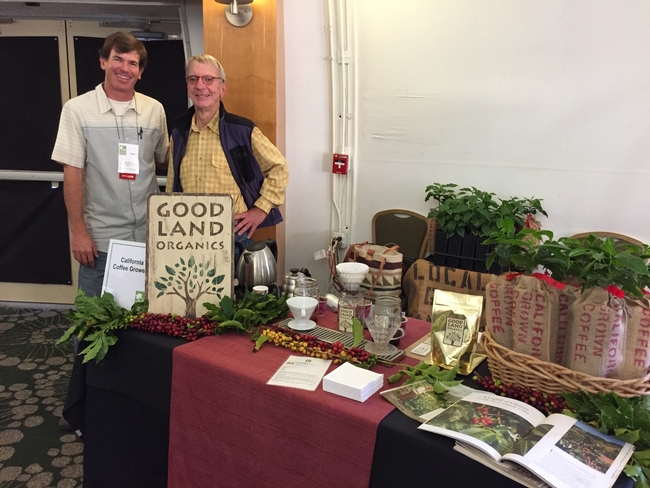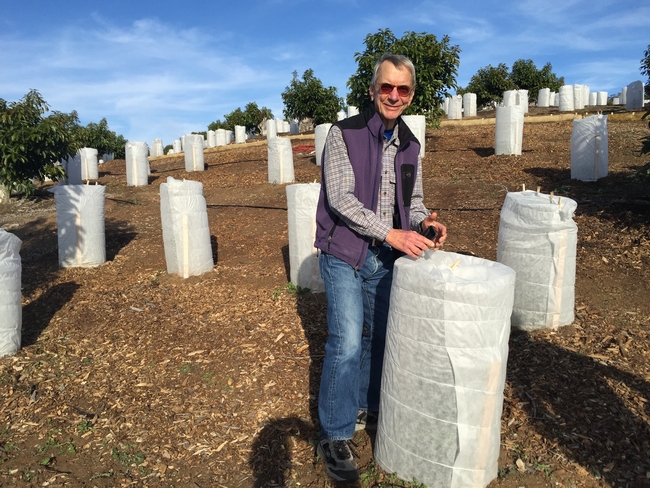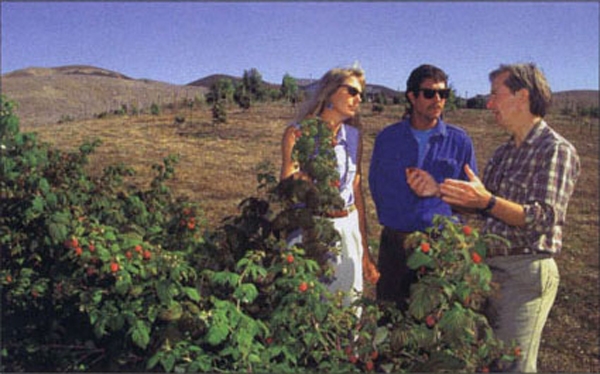
Posts Tagged: blueberries
UCCE small farms advisor Mark Gaskell retires
Mark Gaskell is best known these days for cultivating the idea of California-grown coffee that launched the emerging industry. But coffee isn't the first crop that Gaskell convinced California farmers could be locally grown. For more than 23 years, the UC Cooperative Extension advisor has been researching new specialty crops, such as blueberries, blackberries, raspberries, kiwi berries, Pakistani mulberries, sweet onions, lychees and longans, for small farms to grow for a profit.
Gaskell, who began his career with the University of California's Division of Agriculture and Natural Resources as an advisor for small farms and specialty crops in San Luis Obispo and Santa Barbara counties in 1995, retired July 1.
Blueberries become a California crop
Blueberries weren't grown in California until Gaskell planted test plots of southern highbush blueberries in 1996 to give small-scale growers a new crop option. He hosted his first blueberry field day in 1998. In collaboration with UC Cooperative Extension advisors in other counties, Gaskell identified varieties suited to the local climate and developed cultural practices for California growers to successfully produce blueberries. What was once a niche crop is now planted on over 7,000 acres in the state, according to the California Blueberry Commission. California currently leads U.S. production of fresh blueberries, Gaskell said.
“If it wasn't for Mark Gaskell, I wouldn't have lasted three years,” said Tony Chavez, who grows 40 acres of blueberries, blackberries and some raspberries in Nipomo.
Chavez had grown bored after selling La Tapatia Norcal, a tortilla shop that he operated for 34 years, and retiring in San Luis Obispo County.
“After I retired, I started a little farm. I started with blackberries,” Chavez said. “I have friends who farm. I didn't realize it would be such hard work.”
Someone told Chavez that Gaskell helps small farmers. “He's been my teacher about how to grow berries. Everything I know about farming, I owe to Mark,” said Chavez, who has been working with Gaskell for about 10 years. “I don't know what I'm going to do after he retires. He's a wonderful person and very, very knowledgeable.”
California-grown coffee
Recently Gaskell's knowledge of coffee production has been in demand.
“Personally, I would not be where I am today professionally without Mark's guidance, support and friendship,” said Jay Ruskey, CEO and co-founder of Good Land Organics.
“I met Mark in 1996 through the California Rare Fruit Growers,” Ruskey said. “We started work with lychee and longans and we worked for several years on bringing in plant material and planting trials. He brought me my first coffee plants in 2002.”
The exotic fruit didn't work out for the Goleta grower, but with Gaskell's research-based advice Ruskey has produced premium coffee. His Caturra coffee made Coffee Review's Top 30 coffees in 2014 and in 2017 Daily Coffee News reported that Blue Bottle was selling the California-grown coffee for $18 per ounce.
Prior to joining UC, Gaskell had worked for several years in Central America in coffee growing areas.
“I became curious about coffee in 2000 after I had seen some plants growing at botanical gardens in SoCal, but I assumed the hand labor and processing requirements would prevent profitable growing here,” Gaskell recalled. “About that time, I had the opportunity to visit the coffee production area in Kona on a totally unrelated project – we were doing research with lychees and longans and that is how I began to work with Jay. But visiting coffee farms and the coffee cooperative in Kona made me rethink coffee in SoCal because of similarities to coastal sites around Santa Barbara – Jay's farm – and the fact that costs of water, land and labor were high in Kona and yet they were making a business out of coffee.”
California is now in the coffee business with 15 varieties of Arabica coffee that Gaskell's research has shown are growing well with acceptable yields and high quality.
“Currently, there are about 30 farms with maybe 30,000 coffee plants between San Luis Obispo and San Diego counties,” Gaskell said. “I would expect that to double this year and again next year.”
Ruskey recently co-founded Frinj Coffee, Inc., a company that provides aspiring California coffee growers with plant material and production and marketing advice.
“Industry-wide, there are many farmers who have benefited directly from working with Mark, but there are far more farmers who are currently benefiting today from the specific crops and farming systems he has introduced through his service as a University of California farm advisor,”Ruskey said. “Mark's retirement will certainly leave a resource void for farmers who are looking for allies to help them navigate the complex and dynamic world of farming.”
Educating growers beyond California
Gaskell began his career as an agronomy instructor for four years at Iowa State University, after earning his B.S. in agronomy and his M.S. and Ph.D. in crop physiology and production at Iowa's land-grant college. He became an assistant professor of agronomy from 1980 to 1987 at Rutgers University, where he began working with small farmers in Panama. For two years, he conducted agricultural research in Central America for the U.S. Agency for International Development and became fluent in Spanish. From 1989 to 1992, Gaskell was director of agricultural technical services, overseeing crop production in Latin America and Central America for Chestnut Hill Farms in Miami, before returning to USAID to develop new crops for farmers in Central America.
After joining UC in 1995, the Iowa native continued his international work through consulting projects and sabbatical leave, sharing his expertise in Albania, Portugal, Turkey, Italy, Sicily, France and Spain, Argentina, Bosnia-Herzegovina, Bolivia, Uruguay, El Salvador and Nicaragua.
As a Fulbright Senior Scholar, 2011 to 2014, Gaskell worked with the Moroccan National Agronomic Research Institute training growers and establishing a national research program to develop blueberries, blackberries and raspberries as alternative crops.
Gaskell's achievements were recognized by USDA-National Institute for Food and Agriculture with the 2010 National Extension Excellence Program Award for the UC Small Farm Program Team. In 2007, he was named “Outstanding Educator” by UC Agriculture and Natural Resources.
“My work in California - beyond horticulture and agronomy – has been one of relationships,” Gaskell said. “I have worked with dozens of farmers in San Luis Obispo and Santa Barbara counties, in many cases, for more than 20 years. These farmers have often been collaborators for on-farm trials or educational events, or I have assisted them with farming and marketing, problem-solving with diverse crops and settings. These have been very rich, enjoyable and fulfilling relationships that I will truly miss.”
Free Webinars: Think of the ABCs in Pollination of Specialty Crops
Think of the ABCs: almonds, blueberries and cherries. Then think of watermelons and pumpkins. All those crops will be discussed in a series of free webinars on Ensuring Crop Pollination in U.S. Specialty Crops, set Jan. 24 through March 28. The webinars will feature five researchers with the...
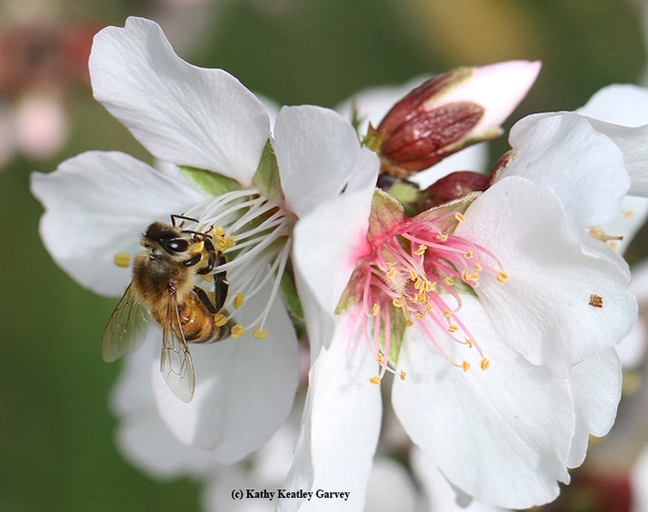
"A" is for almonds. A honey bee pollinating an almond blossom. (Photo by Kathy Keatley Garvey)
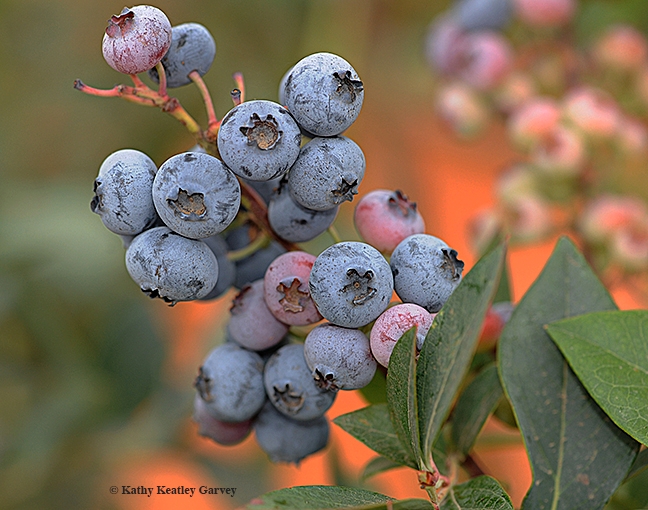
"B" is for blueberries. This is the result of bee pollination. (Photo by Kathy Keatley Garvey)
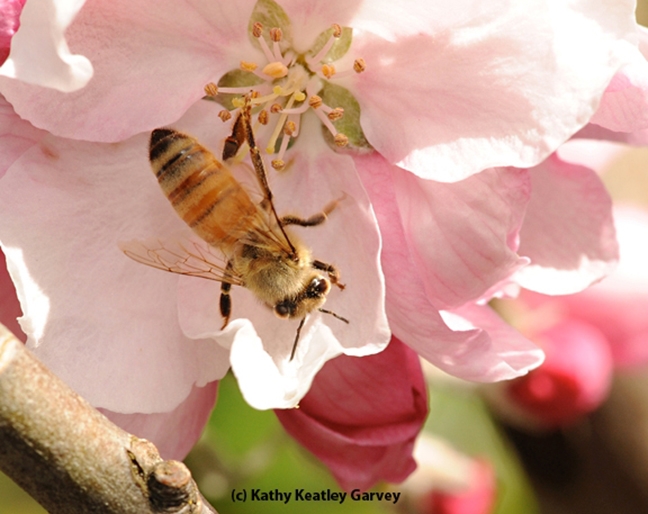
"C" is for cherries. A honey bee pollinating a cherry blossom.(Photo by Kathy Keatley Garvey)
UC Small Farm Advisor works with grower to push the "Horticultural Envelope"
This article by Matt Kettman was published in the Santa Barbara Independent on October 6, 2015. UC Small Farm Advisor, Mark Gaskell, has been providing technical assistance to small-scale growers in Santa Barbara and San Luis Obispo counties for more than 20 years. Sandra Newman has established certified organic blueberries, gooseberries, mulberries, and other specialty crops on her 100 acres of sandy soil and been growing and marketing them successfully for more than a dozen years.
Blueberries, Pinot Noir, Mulberries, and More Thrive at Sandra Newman's Forbidden Fruit Farms Near Lompoc
Story by Matt Kettmann
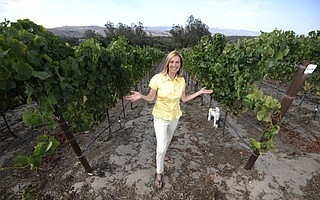
The advisor, however, asked whether she had money and time to burn. As a widow approaching retirement age, lacking a fortune, and still paying bills through her Orange County–based digital SEC filing service, Newman had neither luxury. “I have a budget,” Newman told me during a visit this past summer to the property. “My daddy didn't buy it for me; my husband didn't buy it for me. I'm probably the only one out here who still has a mortgage.”
So the advisor suggested planting blueberries, which, if they ripened anytime other than when the blueberry market is typically flooded, would deliver nearly instant returns. In went two acres of the shrubs — they ripened exactly at the right times — and Forbidden Fruit Orchards was born. Newman was soon selling her organically grown blueberries to upscale grocers and through farmers' markets from San Francisco to Los Angeles, using the proceeds to grow her property from a few abandoned apple trees into a dynamic estate with multiple buildings.
And she kept planting, from more blueberries (now 8.5 acres) to Pakistani mulberries, avocados, apples, red and pink currants, figs, bananas, gooseberries, and more. Among the more interesting choices are the hardy kiwis (smaller than usual and hairless so that you eat the whole thing, but she's still getting them to flower at the right time), green tea (an experimental project in conjunction with the University of California), and hops for beer, which are tended to by Brian DeBolt and Casey Birthisel of Pacific Valley Hops. Many of these items will be integrated into the menu of the upcoming farm-to-table, four-course dinner at the property on November 7, when Chef Sally Ruhl will unveil many of the ingredients she's posting to Twitter under her handle @SallyRuhl.
With the blueberry cash flow, Newman finally did plant wine grapes in 2007, today amounting to 7.5 combined acres of pinot noir and chardonnay. Some grapes are sold to other vintners, but she makes about 600 or so cases in her souped-up garage under the brand Cebada, named after the canyon. The wines are very light and elegant in a deliberately Old World style; the chard is tight and racy, the pinot requires a bit of bottle age to truly shine (so 2011 is great now), and the 2014 rosé is one of the best pinks I've tried of the vintage. Plenty of others think so, too, as it's rare for me to hear so many wine lovers I know rave about the same brand without any prompting.
You can taste them with an appointment at the farm, or just head to Isabella Gourmet Foods on Figueroa Street in downtown Santa Barbara, where Cebada wines are poured upstairs and Newman's jams, teas, and other products are also sold. To get the most bang out of your $10, try them during Thursday and Friday's Classy Hour, when sips come with small food pairings from 4-6 p.m.
Newman also makes a blueberry wine, further evidence that those tiny berries remain the core strength of Forbidden Fruit Orchards. She's currently tending to bidding wars over the recent harvest, since her bushes reach their prime when the market is most desperate. “We hit a really nice window,” she said, “because Chile is not in and the northern hemisphere is done.”
It's certainly not a stress-free existence, and with so many fruits in the air, Newman admits that “sometimes you just have crazy days.” But she's happy with her 100 acres of sand and the evolving cornucopia of trees, vines, and shrubs. “I just love farming,” said Newman. “I love being able to grow and pick the fruit. It's just a passion.”
No Blues for California Blueberries
Summer is upon us, and nothing quite says summer more than eating freshly picked blueberries or using them in delicious desserts. California blueberry growers can find an additional treat – the newly published UC IPM Pest Management Guidelines for blueberry on the UC IPM web site. California is quickly becoming a top producer of blueberries, and the new guidelines can help with management information on blueberry pests such as thrips, light brown apple moth, and spotted wing drosophila with additional information on pesticides and resistance.

In 1995 the University of California Small Farms Program and cooperating farmers started evaluating low-chill southern highbush varieties in San Luis Obispo and Ventura counties. They found that “low-chill” southern highbush varieties offered the most promise for extended season production on the central coast. By 1997, Kearney Agricultural Center trials found that southern highbush cultivars were also well adapted to the semiarid climate of the San Joaquin Valley. Further evaluations identified the best yielding and flavorful cultivars. Initial and ongoing UC Small Farms studies have escalated California blueberry production swiftly up the learning curve, providing California farmers of small to moderate operations a niche in a very competitive market.
Today, California blueberries are harvested from May through July in the San Joaquin Valley and January through May on the central coast. While consumer demands are on the rise and profits can be excellent, producing and harvesting blueberries in California is expensive. It can run over $10,000 per acre to prepare a field because successful cultivation in many areas necessitates soil and irrigation water acidification and adding tons of mulch per acre. Specialized equipment, labor-intensive pruning, and pests like light brown apple moth, thrips, and spotted wing drosophila can add substantially to cost. Therefore, getting the right information and planning is imperative. While the UC Small Farms Program continues to develop field and market research for blueberry production in California, growers can also turn to the newly published Pest Management Guidelines for blueberries.
Can less water grow better berries?
It might be pouring rain today, but soon enough California will be dry again. As demand for water for a growing urban population and for environmental restoration increases, farmers throughout the state are working to grow crops using as little water as possible, and UC is working with them.
"Water supplies are being constrained. Farmers are facing reduced access to water," said Shermain Hardesty, a UC Cooperative Extension specialist in the Department of Agricultural and Resource Economics at UC Davis.

The research involves using some elaborate formulas for determining how much water is needed. UCCE advisor Richard Molinar, working with small farms in Fresno County, is irrigating small plots of strawberries with different amounts of water, some at 125 percent of the normal rate, some at 100 percent, and others at 75 percent and 50 percent of normal. In San Diego County, UCCE advisor Ramiro Lobo is doing similar research on strawberries and blueberries; UCCE advisor Manuel Jimenez is working with blackberries and blueberries in Tulare County; UCCE advisor Aziz Baameur is planting strawberries and blackberries in Santa Clara County, and UCCE advisor Mark Gaskell is studying blackberries in Santa Barbara County.
Once the berries are grown, they need to be tested - and testing means tasting in this project. The research team is holding tasting sessions to let the public judge which berries they prefer. If you've ever tasted a dry-farmed tomato, you might guess the answer. The first tasting session was held at the Davis Farmers' Market in June, with seven more coming soon at farmers' markets and grocery stores around the state.
Taste is a great quality to measure, but only one aspect of the study. Berries are already known for having a high nutrient content, but growing them with less water might give them even higher nutritional value. The team expects to find nutrition density to be highest at the lowest irrigation levels. To test this concept, UCCE specialists Elizabeth Mitcham and Marita Cantwell, experts in postharvest science affiliated with the Department of Plant Sciences at UC Davis, are doing nutritional quality analysis of the berries as they are picked.

"Over-irrigation is cheap insurance, especially for such high value crops," he said.
He explained that more water tends to grow bigger berries. Since the harvest is not mechanized for berry crops, it takes as much effort to pick a small berry as a large berry, making more efficient use of the pickers' time and filling the basket more quickly if the berries are bigger.
Such a trade-off for the farmers! The public may decide that they prefer smaller berries with more taste, and the scientists may decide that smaller berries are more nutritious, but will it be profitable to grow better berries? It may depend on how much smaller, and on how much less water for how much better nutrition and taste. It may depend on the water rates, says Hardesty. She will be taking all of these variables into account to determine the potential impact on profitability of lower irrigation rates on berries.
The team, which also includes UCCE advisors Michael Cahn in Monterey County and David Shaw in San Diego, will report the results of their study to California farmers in the final year of the project. This project is funded by a California Department of Food and Agriculture Specialty Crop Block Grant.

